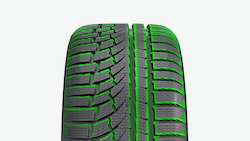Most people are interested in tires that they can use throughout the year. There are two such tires, all-season tires and all-weather tires. To choose which one is the best for you, you need to be aware of the differences. The main difference and probably the deciding factor of which car tires to ultimately choose is that only the all-weather tires are approved for winter use and have the “Three Peak Mountain Snowflake” emblem marked on the sidewall. This proves that these tires have passed critical performance criteria on snow and ice. If you need tires that are approved for snow, then all-weather tires would be your choice.
If you live in a region of the United States with snow and ice in the winter and you don’t want to consider snow and winter tires, then all-weather tires are for you. With all-weather tires holding the same snow service rating as winter and snow tires, you can rest assured that you will be safe using them on snow and ice. Recent testing has proven all-weather tires to be equally good to snow tires and at times even surpass their performance. This makes the all-weather tires an excellent choice in areas with snow and ice in the winter. Not only will you have the convenience that these tires can be used throughout the year, but you will also have the advantage of being prepared for any type of weather, no matter what the forecast. In addition, you won’t have to time the transition to winter tires, which can be quite tricky if living in an area with Another significant advantage. This makes all-weather tires the best choice in areas with rapidly changing seasons.
If, however you live in one of the many areas of the United States where the weather allows for all-season tires, then these tires are a great choice. All-season tires have low rolling resistance, extending the tread durability while saving you money at the pumps. All-season with their less aggressive tread allows for excellent handling and comfort while offering protection against hydroplaning.
When deciding whether to choose all-weather tires or all-season tires, keep in mind to respect the manufacturer’s recommendations for tire dimensions. Tires with the dimension of 225/65R17, should be replaced with tires of the same dimensions. In other words, either 225/65R17 all-season tires or 225/65R17 all-weather tires.
Now that you know the difference between all-weather tires and all-season tires, the decision of which ones to get should be fairly straightforward. Both all-weather tires and all-season tires have had many recent innovations making them more eco-friendly with lower rolling resistance allowing for lower emissions and better fuel economy. Features to protect against hydroplaning and better grip and traction are just some of the other innovations. Most people nowadays enjoy having tires that can be used year-round, forgoing the need to change tires seasonally, and most tire manufacturers place year-round tires on their new cars. Probably the most common being the all-season tires.
For more information regarding all-weather tires, visit: https://www.nokiantires.com/
